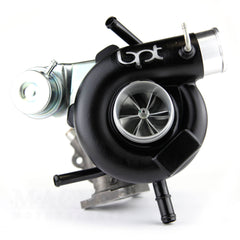Your Cart is Empty
 The factory turbo has limited air flow capability at high rpms, and high boost at high rpms is how you make lots of horsepower! There are many turbo choices you can make to solve the high-end wheeze. Most (but not all) of them bolt directly onto the factory intake and exhaust piping. A turbo that fits in place of the stock turbo, on the stock up pipe and connect to the stock (or stock location) downpipe is known as a "stock location" turbo. A turbocharger that is so large that it must pivot to the side to avoid bumping into the intake manifold is called a "rotated mount" turbo. The rotated mount turbo generally will make even more horsepower than a stock location turbo, but will require a new and different up pipe and downpipe, different intake plumbing, and likely an external wastegate. All of those things make the rotated mount solution far much expensive than a stock location upgrade.
The factory turbo has limited air flow capability at high rpms, and high boost at high rpms is how you make lots of horsepower! There are many turbo choices you can make to solve the high-end wheeze. Most (but not all) of them bolt directly onto the factory intake and exhaust piping. A turbo that fits in place of the stock turbo, on the stock up pipe and connect to the stock (or stock location) downpipe is known as a "stock location" turbo. A turbocharger that is so large that it must pivot to the side to avoid bumping into the intake manifold is called a "rotated mount" turbo. The rotated mount turbo generally will make even more horsepower than a stock location turbo, but will require a new and different up pipe and downpipe, different intake plumbing, and likely an external wastegate. All of those things make the rotated mount solution far much expensive than a stock location upgrade.
Note that turbo size is going to be the biggest predictor of how quickly the turbo spools, which in turn will affect how soon the car will make boost after you depress the gas pedal. Larger turbos generally will have more top-end power capacity, but will spool up more slowly. We generally advise that you choose the smallest turbo that will make the power target you have chosen. Too large of a turbo will make the car very lazy to drive under normal daily use, even if the top-end punch is great.
Our preferred turbo supplier is Blouch Turbo. They make a a complete line of turbo upgrades for the Subaru, from mild to huge and crazy. The Blouch 20G XT-R pictured here is a very popular upgrade for 2.5 liter Subaru cars.
Once you have upgraded the turbo you are going to outstrip the ability of the stock fuel injectors and fuel pump to deliver fuel, so you will have to go with upgraded fuel injectors and fuel pump. (Direct-injection cars like the 2015+ WRX will only need to upgrade the low-pressure fuel pump in the fuel tank; the high-pressure pump and fuel injectors have enough headroom to supply significantly more fuel than the stock power level demands.)